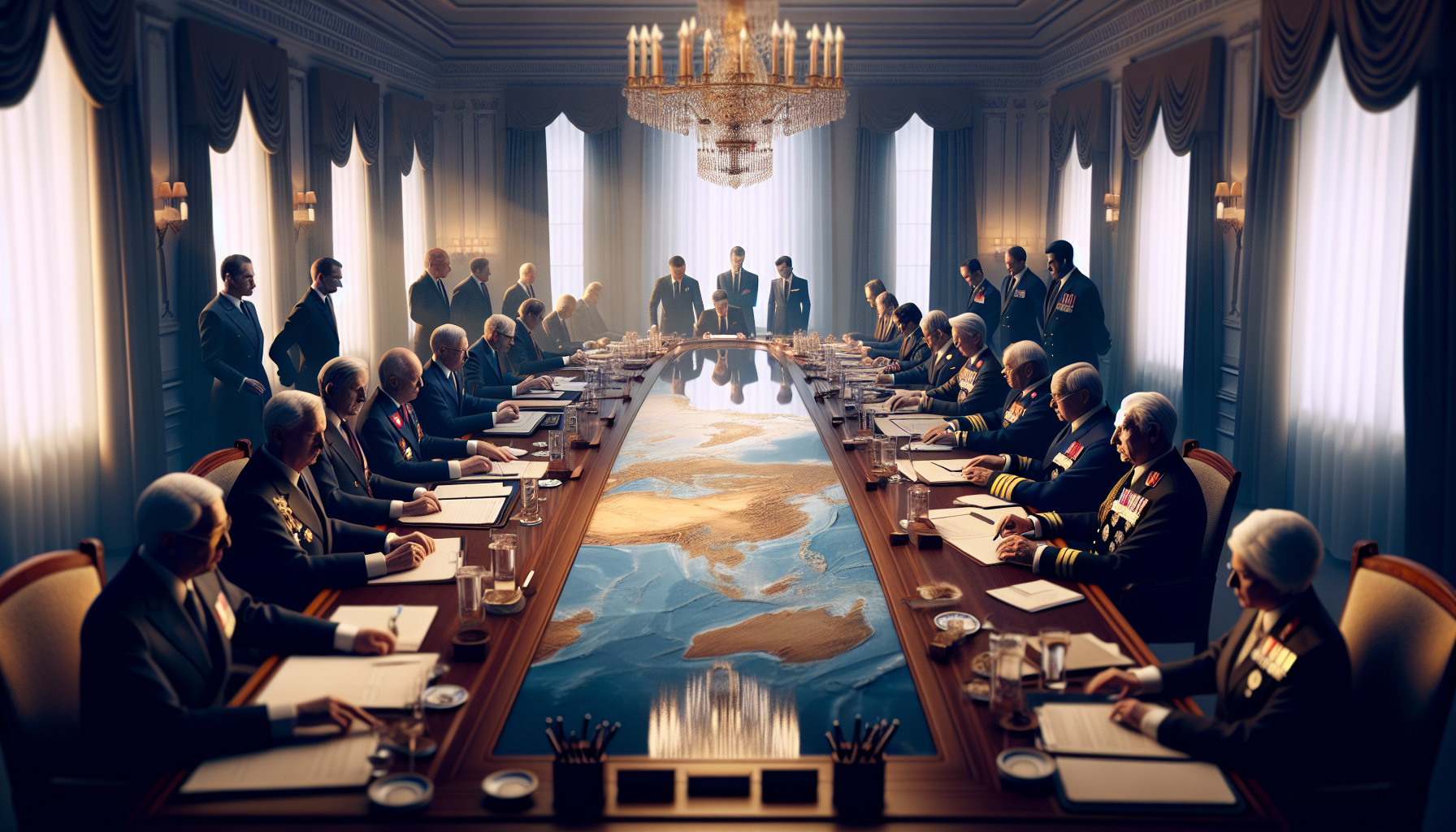In an increasingly interconnected world, the notion of peace often seems both elusive and indispensable. While we frequently hear about international diplomacy on a grand scale, the intriguing world of micronations offers a unique and microcosmic perspective on conflict resolution. These small, often unrecognized entities pepper the globe, each with its own aspirations, governance, and challenges. “Peace Through Diplomacy: Navigating Micronational Conflict Resolution with Skill and Strategy” invites you to delve into this fascinating universe where the stakes are smaller, but the lessons can be monumental. 🌍
Micronations, despite their modest size and recognition, often mirror the complexities of international relations. They face territorial disputes, ideological differences, and governance challenges, much like their larger counterparts. Yet, the path to peace in these diminutive domains offers a unique opportunity to witness diplomacy in its purest form. Here, leaders must rely on creativity, dialogue, and strategic finesse to address disputes and foster harmony. This article will journey through the delicate art of conflict resolution within micronations, highlighting key strategies and showcasing examples of successful diplomacy. 🕊️
At the heart of this exploration lies the fundamental question: How do micronations, often lacking formal recognition and resources, manage to resolve conflicts effectively? The answers reveal a tapestry of diplomatic skills, including negotiation, mediation, and the art of compromise. These entities often engage in dialogue that is as nuanced and sophisticated as any conducted on the world stage. The principles guiding these interactions can serve as powerful lessons for larger nations grappling with their own conflicts. In a world yearning for peace, the innovative strategies employed by micronations offer hope and inspiration.
Throughout this article, we will uncover the mechanisms that empower micronations to navigate conflicts peacefully. We will delve into the role of leadership in fostering a culture of diplomacy, the impact of historical context on current disputes, and the innovative use of technology and social media to bridge divides. Additionally, we will explore the importance of cultural understanding and empathy in crafting sustainable solutions. By examining these elements, we aim to illuminate how even the smallest players on the global stage can wield considerable influence in the pursuit of peace.
As we embark on this enlightening exploration, we invite you to consider the broader implications of micronational diplomacy. What can these small-scale examples teach us about resolving larger geopolitical conflicts? How can the creativity and adaptability seen in these microcosms inform broader international relations? Through examining the successes and challenges faced by micronations, we can glean valuable insights into the universal quest for peace. Join us as we navigate the fascinating world of micronational diplomacy, where every negotiation holds the promise of a more harmonious future. 🌟
The Rise of Micronations and Their Unique Diplomatic Challenges
The phenomenon of micronations has fascinated both scholars and enthusiasts for decades. Micronations are small, self-proclaimed entities that claim independence but are not recognized as sovereign states by world governments or major international organizations. Despite their small size, these entities often face diplomatic challenges similar to those of established nations. The nuanced art of diplomacy within these micro-entities is crucial for their survival and growth.
Micronations can vary widely in terms of their formation, purpose, and governance. Some emerge as social experiments, others as political statements, and some even as artistic endeavors. Regardless of their origins, they often seek to establish themselves on the world stage, albeit on a smaller scale. This quest for recognition and stability brings about unique diplomatic challenges that require skillful negotiation and strategy.
The diplomacy of micronations is a delicate balance between aspiration and realism. Leaders of these entities must navigate a complex landscape where they seek to assert sovereignty while often lacking resources and international recognition. This calls for innovative approaches to diplomacy, including forming alliances with other micronations, participating in international forums, and engaging with global media to tell their stories. The strategic use of these tools can aid micronations in achieving their goals, whether they be cultural recognition or increased autonomy.
Table: Comparison of Recognized Nations and Micronations
| Aspect | Recognized Nations | Micronations |
|---|---|---|
| International Recognition | Full recognition by the UN and global community | Limited or no recognition |
| Population | Varies from thousands to billions | Typically fewer than 100 citizens |
| Diplomatic Reach | Embassies and consulates worldwide | Online presence and informal meetings |
Strategies for Effective Micronational Diplomacy
Micronations must employ creative strategies to navigate their diplomatic endeavors effectively. One key approach is leveraging the power of the internet and social media. These platforms allow micronations to broadcast their existence and communicate with potential allies and supporters worldwide. By crafting compelling narratives and utilizing visual media, micronations can capture attention and foster engagement.
An effective strategy for micronational diplomacy is participating in intermicronational organizations. These alliances provide a platform for dialogue, collaboration, and mutual recognition. By joining such groups, micronations can amplify their voices and work together to address common challenges. Furthermore, these organizations often serve as a springboard for developing diplomatic protocols and building a sense of community among diverse micronations.
Another essential strategy is focusing on cultural diplomacy. Many micronations emphasize their unique cultural identities as a means of garnering interest and support. By hosting cultural events, exhibitions, and online campaigns, micronations can showcase their heritage and attract international attention. This approach not only strengthens their internal cohesion but also helps build bridges with external audiences.
- Utilize social media for global outreach
- Join intermicronational organizations for collective strength
- Engage in cultural diplomacy to showcase uniqueness
Video: An Introduction to Micronations
For a visual exploration of the world of micronations, check out this informative video: Micronations: The Unseen Sovereignties by National Geographic.
Skillful Negotiation and Conflict Resolution
The art of negotiation is vital for any diplomatic effort, and micronations are no exception. With limited resources and recognition, leaders of micronations must become adept negotiators. Effective negotiation involves understanding the needs and motivations of other parties, finding common ground, and crafting win-win solutions. For micronations, this often means creatively addressing disputes and building relationships based on mutual benefit.
Micronational conflicts can arise from territorial claims, ideological differences, or even interpersonal disagreements within the community. Addressing these conflicts requires a structured approach to conflict resolution. Mediation, arbitration, and dialogue are essential tools for resolving disputes peacefully. Additionally, the presence of a neutral third party can help facilitate discussions and ensure fairness.
It’s important for micronations to document their negotiations and agreements. This transparency not only builds trust but also serves as a reference for future interactions. By maintaining records, micronations can demonstrate their commitment to diplomacy and accountability, which can enhance their credibility on the international stage.
Table: Conflict Resolution Techniques for Micronations
| Technique | Description |
|---|---|
| Mediation | Involves a neutral third party to help facilitate dialogue |
| Arbitration | A binding decision is made by an impartial party |
| Dialogue | Open discussions to find mutually acceptable solutions |
Embrace these techniques to enhance diplomatic relations and peacefully resolve conflicts. The path to sustainable peace in the micronational world is paved with skillful negotiation and a commitment to dialogue. 🌍

Conclusion
In conclusion, the intricate and multifaceted nature of diplomacy in the realm of micronations presents both challenges and opportunities. Throughout this article, we have explored how diplomacy serves as a vital tool for navigating conflicts, promoting peace, and fostering mutual understanding among these small, yet increasingly significant entities. As we recapitulated the main points, we emphasized the necessity of diplomatic skill and strategic thinking in resolving disputes and advancing shared interests.
Firstly, we examined the fundamental role that communication plays in diplomacy. Effective communication is not merely about exchanging information; it involves building trust, understanding cultural nuances, and engaging in active listening. These components are crucial in preventing misunderstandings that can escalate into conflicts. The importance of cultural competence cannot be overstated, as it aids in bridging gaps and forging stronger, more resilient relationships between micronations.
Secondly, we delved into the strategies employed in conflict resolution. From negotiation and mediation to arbitration, the spectrum of diplomatic strategies offers various pathways to peaceful resolutions. Each approach has its unique advantages, and the choice of strategy often depends on the context and the specificities of the conflict at hand. By employing a tailored approach, micronations can not only resolve current disputes but also lay the groundwork for long-term peace and cooperation.
Furthermore, we highlighted the role of international law and organizations in supporting micronational diplomacy. These entities provide frameworks and platforms for dialogue, facilitating the peaceful resolution of conflicts and promoting the rule of law. Engaging with international bodies not only legitimizes micronations on the global stage but also enhances their ability to influence broader geopolitical dynamics.
We also addressed the technological advancements that have revolutionized diplomatic practices. Digital diplomacy, for instance, offers micronations unprecedented opportunities to engage with a global audience, share their perspectives, and advocate for their interests. Social media platforms and digital communication tools have become indispensable in amplifying the voices of micronations and fostering a sense of community among them.
In reinforcing the significance of diplomacy, it is essential to recognize its impact not just on the immediate parties involved but also on the broader international community. Peaceful resolution of conflicts among micronations contributes to global stability and security, setting an example for larger nations to follow. The principles of diplomacy—mutual respect, dialogue, and cooperation—are universal and applicable at all levels of international relations.
As readers, it is crucial to appreciate the nuances of diplomatic practice and the value it brings in maintaining peace and harmony. Whether you are a diplomat, a scholar, or simply someone interested in international relations, the lessons from micronational diplomacy offer valuable insights into the art of negotiation and conflict resolution.
We encourage you to reflect on the ideas discussed in this article and consider how you can apply them in your own contexts. Whether it’s engaging in discussions, sharing your perspectives on social media, or participating in diplomatic simulations, your involvement can make a difference. Moreover, sharing this knowledge with others amplifies its impact, fostering a community committed to peace and understanding.
In closing, let us embrace the spirit of diplomacy and strive for a world where conflicts are resolved not through force, but through dialogue and cooperation. The journey towards peace is continuous, and every step taken in the right direction counts. 🌍🤝
For further reading and resources on micronational diplomacy, consider exploring reputable sources such as The Diplomat and Council on Foreign Relations. These platforms provide a wealth of information on international relations and diplomacy, offering insights that can enhance your understanding and engagement with global issues.
Thank you for joining us on this exploration of peace through diplomacy. We hope it has inspired you to think critically and act compassionately in your own endeavors. Feel free to share your thoughts, engage with others, and be a part of the solution. Let’s continue the conversation and work towards a more peaceful world together.
Toni Santos is a visual storyteller and artisan whose creations celebrate the poetry of the natural world. Through his thoughtful artistic lens, Toni captures the elegance of botanical forms, transforming them into meaningful expressions of symbolism, resilience, and timeless beauty.
His journey is deeply rooted in a passion for flora and the mysteries they carry. From the shape of a petal to the curve of a vine, each design Toni brings to life reflects a deeper narrative — one of growth, transformation, and harmony with nature. Whether crafting symbolic floral jewelry, enchanted botanical illustrations, or seasonal visual studies, Toni’s work evokes the quiet magic found in Earth’s most delicate details.
With a background in handcrafted artistry and visual design, Toni blends technique with intention. His creations do more than decorate — they speak, often inspired by ancient meanings behind flowers, the cycles of the seasons, and the invisible bonds between nature and spirit.
As the creative voice behind Vizovex, Toni shares this botanical journey with the world, offering curated stories, handcrafted collections, and thoughtful articles that help others reconnect with nature’s symbolism and artistic essence.
His work is a tribute to:
The quiet power of flowers and their messages
The art of visual symbolism in everyday life
The beauty of slowing down to see what’s hidden in plain sight
Whether you’re an artist, a nature lover, or someone drawn to the deeper meanings behind the natural world, Toni welcomes you to explore a space where aesthetics meet soul — one petal, one story, one creation at a time.





